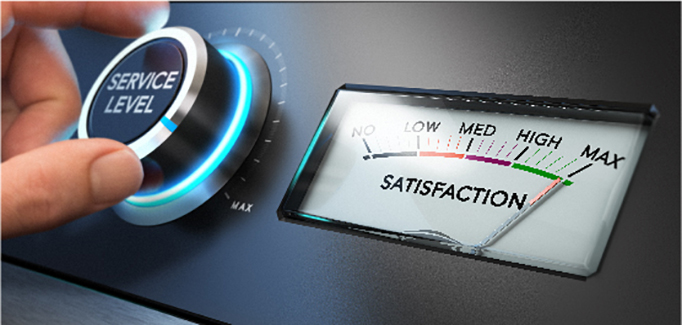Customer loyalty for Apple is at an all-time high—92%, and that’s no accident. The company is known for its investment in building customer loyalty, and it is reaping the rewards: Apple users are 18% more loyal to the brand than to its biggest Android competitor.
Under Steve Jobs’ leadership, the company served as a case study of how even a utilitarian object like a phone or a computer can create fiercely loyal customers—customers willing to pay a premium. That loyalty stemmed not only from Jobs’ passion for Apple products and their high-quality and user-friendly design but also the emotional connection Apple has been able to build with consumers of all ages.
Across industries, companies are realizing the benefits of customer loyalty. Simply put, customer loyalty is the act of repeatedly choosing one company’s products and services over those of another. It’s the byproduct of all of the experiences a customer has with your organization.
Loyalty gives customers a reason to return (and when they do, they spend more on products and services than new customers). Loyal customers refer friends and family more often. As Apple and many other brands with loyal customers have seen, loyalty enables you to price products at a premium (repeat customers are more likely to buy from you than from the competition, even when the competition is selling the same product at a lower price). And with the cost of acquiring new customers having increased in recent years, customer loyalty provides a distinct ROI.
Customer Service and Loyalty Go Hand in Hand
Customer service matters: Nearly three in four of businesses that provide an above-average customer experience are better off financially than their competitors, and 90% of people say customer service is important to their choice of and loyalty to a brand.
Because customer loyalty is the result of the sum of a customer’s interactions with a brand, each and every interaction is significant. And customers’ expectations for those interactions continue to increase—customer-obsessed companies like Apple and Zappos have raised the bar for everyone else.
Customers today expect seamless customer service across channels, and they expect it quickly. How long is too long? What’s acceptable in terms of wait time differs widely between customers—some people are naturally more patient, after all—but one industry publication defines omnichannel industry standards as follows: [1]
- Phone: 80% of calls answered within 20 seconds.
- Email: 95% of emails answered within four hours.
- Letters: 95% of letters answered within three days.
- Social media: 80% of contacts answered within 20 minutes.
- Live chat: 80% of chats answered within 40 seconds.
- SMS/messaging apps: 80% of messages responded to within 40 seconds.
A few key tactics can help you deliver the service that will turn customers into fiercely loyal advocates. Here’s how.
Personalize Customer Service
Take advantage of technology, like omnichannel analytics, to understand your customers. By quantitatively tracking trends and satisfaction, you can unlock actionable insights from every customer interaction to guide initiatives for measurable improvement in customer experience and agent performance.
Improve First-call Resolution (FCR)
With a holistic view of customers and their history of conversations, agents can use this information in real time to improve CX and FCR. In fact, researchers have found a link between FCR and customer satisfaction. As use of AI increases in the contact center, the FCR metric can also reflect instances where issues are resolved without any agent interaction with the customers.
Enable Agents to Build Strong Relationships
As the face of the organization, agents play a critical role in creating the types of strong relationships that drive loyalty. Among the behaviors proven to impact customer satisfaction and loyalty:
- Demonstrating ownership.
- Active listening.
- Empathy.
- Rapport.
- Expectation setting.
- Effective questioning.
- Promoting self-service.
- Inappropriate action.
- Acknowledging loyalty.
Focus on Feedback
In order to improve your business, and ultimately customer loyalty, you need honest feedback from customers. “Every business has room for improvement,” according to Forbes. “However, knowing where you’re succeeding and where you’re lacking is crucial before making any major changes; otherwise, you're making changes for change's sake, which is, at best, treading water while wasting resources.”
The key is to go beyond traditional post-call surveys, which can overlook the root cause of a customer’s dissatisfaction. Instead, personalize feedback with AI-enabled targeted surveys on the customer’s preferred channel of communication. These are AI-enabled surveys that provide relevant and contextual questions to a customer to address their needs with a higher likelihood of eliciting a response.
The Takeaway? Relationships Improve Customer Loyalty
The importance of customer loyalty transcends industries. With consumer demands higher than ever, contact centers must engage with customers at a deeper level. After all, for customers to return and refer the business to others, they must feel cared for. Taking steps to forge a meaningful relationship, whether by delivering great service, personalizing calls or another tactic, will deliver benefits that far exceed the investment required. Learn more about how NICE is helping leading organizations predict (and prevent) churn and drive customer loyalty with Customer Experience Analytics, or read our guide to customer satisfaction (CSAT).
[1] “Omnichannel – What Is an Acceptable Waiting Time?” Call Centre Helper.



